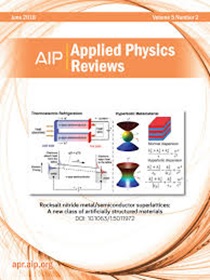热在后硅电子中的作用
IF 11.6
1区 物理与天体物理
Q1 PHYSICS, APPLIED
引用次数: 0
摘要
由于巨大的静态和动态功耗,热管理是现代硅基计算机的主要挑战。越来越多的人认为,热量可以在后硅设备中作为信息载体(而不是被视为无用的副产品),从而实现新功能和芯片上的能量回收。在这篇综述中,我们介绍了如何在电子设备中利用热量作为自由度,以及这些设备如何使高效计算机成为可能。本文章由计算机程序翻译,如有差异,请以英文原文为准。
Role of heat in post-silicon electronics
Managing heat is a major challenge in modern silicon-based computers due to both large static and dynamic power dissipations. There is a growing perspective that heat can serve as an information carrier (instead of being treated as a useless by-product) in post-silicon devices, enabling new functions and on-chip energy recycling. In this review, we introduce how heat can be utilized as a degree of freedom in electronic devices, and how such devices may enable efficient computers.
求助全文
通过发布文献求助,成功后即可免费获取论文全文。
去求助
来源期刊

Applied physics reviews
PHYSICS, APPLIED-
CiteScore
22.50
自引率
2.00%
发文量
113
审稿时长
2 months
期刊介绍:
Applied Physics Reviews (APR) is a journal featuring articles on critical topics in experimental or theoretical research in applied physics and applications of physics to other scientific and engineering branches. The publication includes two main types of articles:
Original Research: These articles report on high-quality, novel research studies that are of significant interest to the applied physics community.
Reviews: Review articles in APR can either be authoritative and comprehensive assessments of established areas of applied physics or short, timely reviews of recent advances in established fields or emerging areas of applied physics.
 求助内容:
求助内容: 应助结果提醒方式:
应助结果提醒方式:


